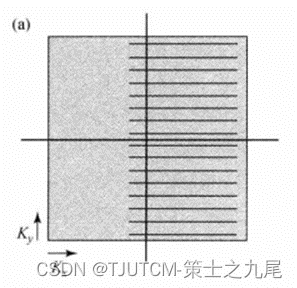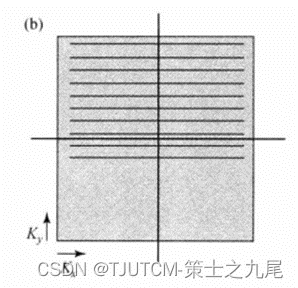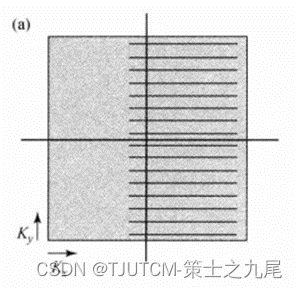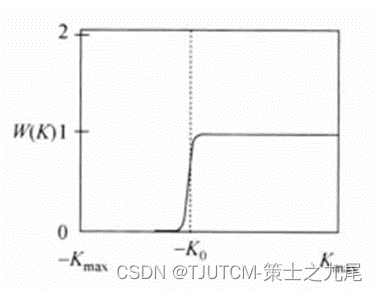Table of contents
1. Partial Fourier reconstruction
In a partial Fourier acquisition, the data is not collected symmetrically about the center of K-space , but instead half of the K-space is completely filled and the other half is only collected with a small portion of data .
The principle behind partial Fourier acquisition is the: If the object is real, its Fourier transform is Hermitian, which means that the real part is symmetric around the center of K-space, and the imaginary part is antisymmetric .
in frequency and phase directionThe main advantages of partial Fourier acquisitionis to reduce the echo time (TE) and scan time respectively . In the frequency-encoding direction, partial Fourier acquisition also reduces gradient moments along this axis, reducing flow and motion artifacts . The spatial resolution determined by the maximum range of K-space is not affected, which is equivalent to the acquisition of full K-space, but the SNR is reduced , and some image artifacts may be introduced.
However, harmful phase shifts caused by many factors such as motion, resonance frequency shift, hardware group delay, eddy current, field inhomogeneity of receiving coil B1, etc., distort the built image . Therefore, extra data (sometimes called "overscan data") in the half-k-space shown in the figure that is not completely filled is used to overcome these problems.
Partial Fourier acquisition can also be used for slice selection directions for 3D scanning (i.e. the second phase encoding direction), but not universally. Because the number of phase encoding steps in the layer is generally not very large, considering that some overscan data is needed, the time saving is not particularly significant .


(a) covers part of K space along the direction of frequency encoding (part of Kx or part of echo)
(b) covers part of K space along the direction of phase encoding (part of Ky or part of Nex)
2. Partial Fourier reconstruction algorithm
2.1 Zero padding
zero fill isUnmeasured k-space data is replaced with zeros and then conventionally reconstructed to obtain an image. For full K-space acquisition , zero-filling of raw data is commonly used to interpolate images and reduce partial volume effects ; for partial Fourier acquisition , zero-filling can be used to replace unmeasured data , and extra data can be added if image interpolation is desired of zero. After zero-filling, full K-space reconstruction based on the standard Fourier transform can be used . Zero padding often results in some Gibbs beating artifacts
near sharp edges , yesCaused by K-space data truncation. The advantage of zero filling is that it can give a more realistic image in the low spatial frequency overscan range of the object . For this low spatial frequency range, phase information is preserved. Thus, the phase of large structures is accurate, allowing zero-filling due to phase-sensitive reconstruction . Reasonable phase accuracy usually requires acquisition of a relatively high fraction of k-space, such as 0.75 or higher.


(a) covers part of K space along the direction of frequency encoding (part of Kx or part of echo)
(b) covers part of K space along the direction of phase encoding (part of Ky or part of Nex)
2.2 Homodyne processing
Homodyne processing isUse the low spatial frequency phase map generated from its own data to correct the phase error caused by incomplete K-space data reconstruction. Homodyne processing utilizes the Hermitian conjugate symmetry of K-space data . Homodyne is not suitable for those applications that require image phase, such as shimming, phase contrast (reconstructed with phase difference), and phase-sensitive thermography; however, complex difference phase contrast can be used with homodyne if the complex difference operation is performed in k-space imaging .


Inductors block high-frequency signals and allow low-frequency signals to pass, while capacitors have the opposite characteristics. A filter that can pass a signal through an inductor, or a filter that is connected to ground through a capacitor, has less attenuation for low-frequency signals than high-frequency signals , and is called a low-pass filter .
The simplest high-pass filter is a " first-order high-pass filter ". Its characteristics are generally expressed by a first-order linear differential equation, and its left side is exactly the same as the first-order low-pass filter.Only the right side is the derivative of the excitation source and not the excitation source itself. When lower frequencies pass through the system, there is little or no output, while higher frequencies are less attenuated when passed through the system . In fact, for extremely high frequencies, the capacitor is equivalent to a "short circuit", and these frequencies can basically obtain an output at both ends of the resistor. In other words, this system is suitable for passing high frequencies and has a greater blocking effect on low frequencies. It is the simplest " high-pass filter ".
The disadvantage of the homodyne method is thatThe low-frequency phase map used in the equation cannot accurately describe the rapidly changing phase. To solve this problem, an iterative partial Fourier method can be used . this methodEstimate the model image with homodyne reconstruction while estimating the phase from the low-frequency phase map. Combining the estimated modulus image and phase image gives a complex image, and the estimated K-space data can be obtained by Fourier transforming the complex image.

If partial Fourier acquisitions are used in two orthogonal directions , one direction can be processed with homodyne reconstruction, while the other can only be processed with zero padding, assuming the partial acquisition fraction is greater than 0.5. That is, if partial Fourier acquisitions are only used in one direction, the other directions must first be processed with the normal (ie full K-space) algorithm .